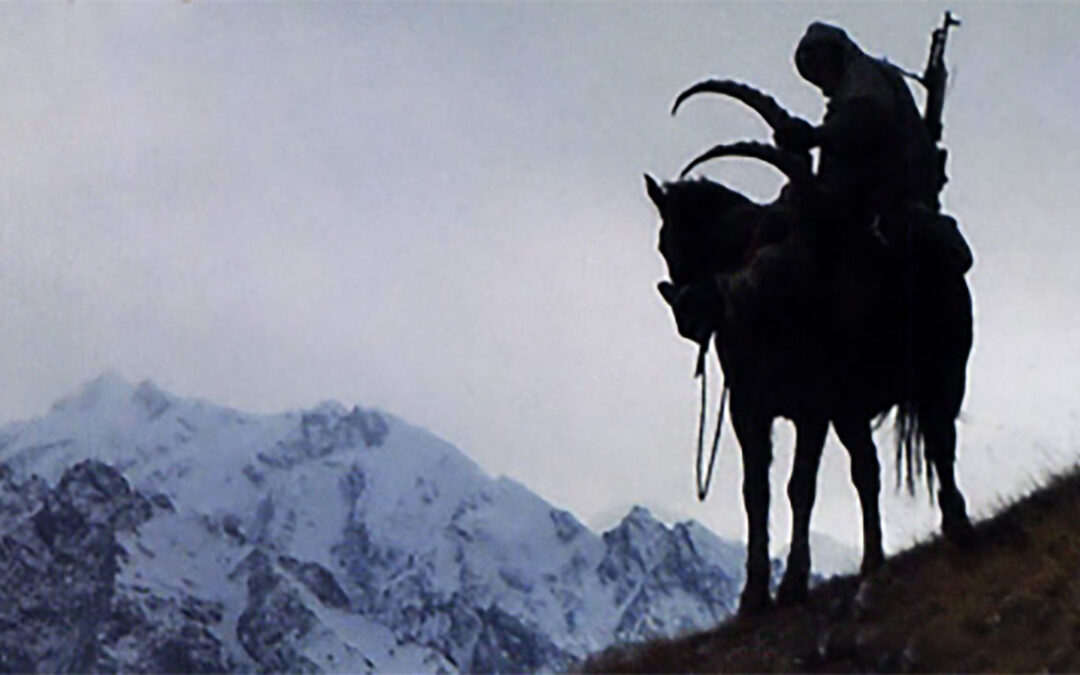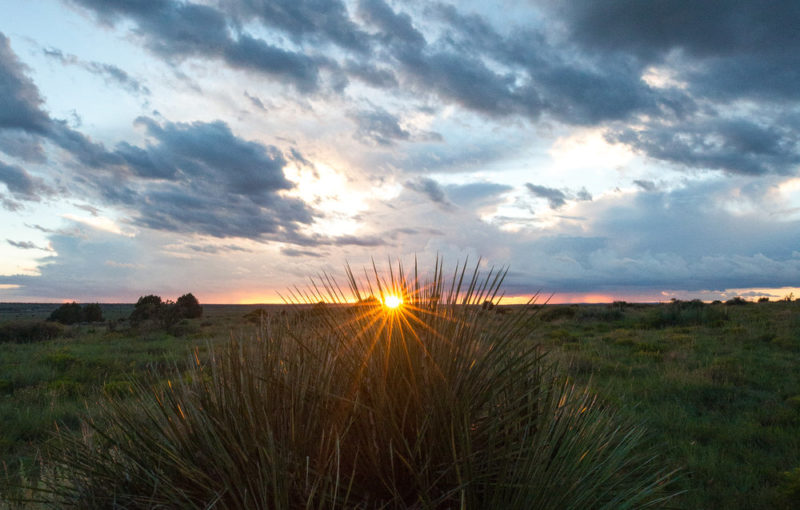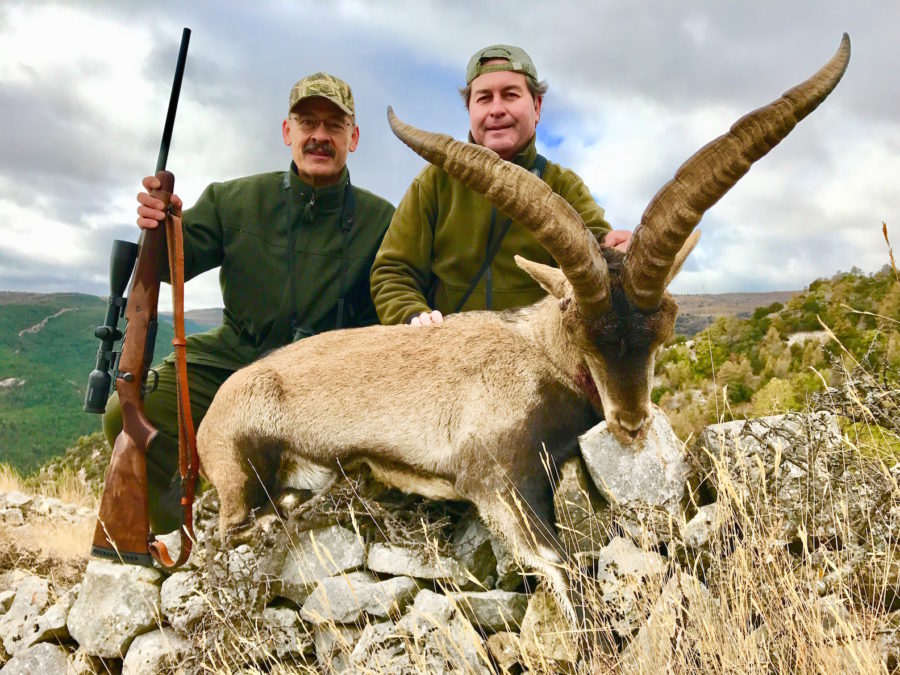And here, among these crumbling cliffs and dizzying heights, I had come to hunt the Siberian Mid-Asian ibex in the dark heart and sharp teeth of dead winter.
Eons ago, in a great battle of continents, the Indian and Eurasian plates collided with planetary force, stacking mountains upon mountains, each rising higher, one on top of the other into the heavens themselves. This epic clash created the towering Tian Shan Celestial Mountains, which today form the heart and spine of Kyrgyzstan. And sitting at its throne like a colossal God crowned with glacial ice is 23,000-foot Khan Tengri, or “Lord of the Spirits,” which at sunset glows a blood red, as if reflecting the land’s violent past.
These are the lands where Genghis Khan swept through, wiping entire regions of people off the face of the earth. Here, where snow leopards lurk and eagles with the ferocity to hunt and slay wolves is a land steeped in mystery and legend, and a people both tempered and blessed by its harsh yet graceful realities.
For years I had been fascinated with ibex and the exotic and forbidding mountains in which they have. Pictures of hunters wearing fur hats and exhausted smiles; turbaned guides wrapped in sash with black beards and weather-beaten faces as hard as chiseled granite, stood proudly amidst the jagged crags. I yearned to be the hunter in the fur hat. I wanted to go where they lived. I wanted to hunt ibex.
Sometimes the winds of fortune blow you to strange places. The long path up to the hunting area was through a great mountain gorge of stone, snow and sheer slides. It appeared that some other-world giant had dragged a pick axe through these mountains, creating this great gash in the land. While avalanches lurked from above, we drove through endless rock formations, occasionally passing hulking iron-and-brick skeletons of Russian mines, now abandoned along with the Socialist dream.
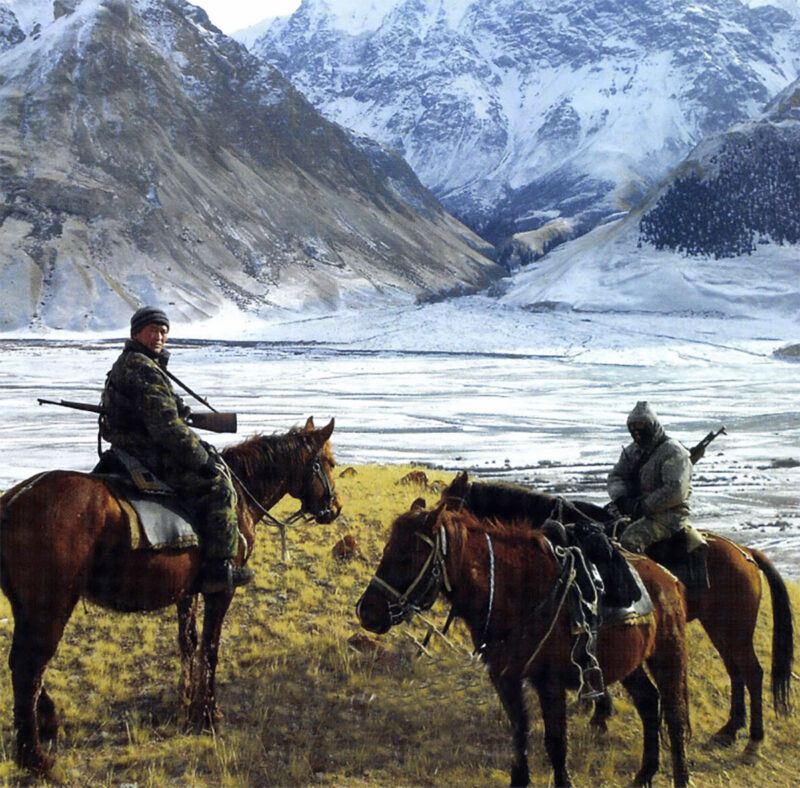
“Sometimes the winds of fortune blow you to strange places.”
The mountain air was shockingly cold when we arrived at base camp in the black of night. The hard-packed snow creaked with each step and our crystallized breaths became ghost-like apparitions drifting in the beams of our head lamps. Our crude brick camp-house seemed like a warm cocoon in the numbing cold.
At dawn the next morning, burnished silver light scoured the long glacier-gouged valley. The high-water mark on the rocks told of a vast river that would swell to a mile wide during spring thaw. Those sprawling waters had marched on, leaving just a few scattered patches of ice in the riverbed, bracketed by mountains that rose thousands of feet above us.
I had not brought my own gun, for a variety of reasons, but I’d been assured that a scoped rifle would be waiting for me. It had a scope alright, but an AK-47 sniper rifle was not what I’d had in mind. Wrapped in tattered cloth rags, battered and pitted like an old axe blade, the rifle looked like it came from a Goodwill gun shop.
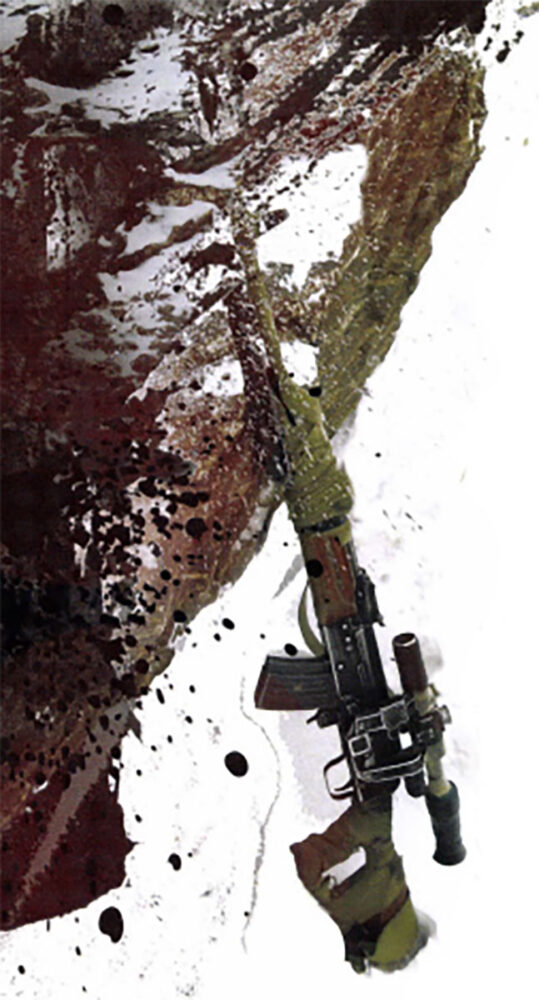
“…an AK-47 sniper rifle was not what I had in mind. Wrapped in tattered cloth rags, batter and pitted like an old axe blade, the rifle looked like it came from a goodwill gun shop.
I was quite familiar with this simple battlefield rifle that had changed the course of history, its signature clatter mixed with yells for revolution heard around the world. Built with Russian iron and common sense, but not known for hair-splitting accuracy.
Peering through the scope, I was surprised by its clear field-of-view sprinkled with an assortment of crosshairs, gradient scales, cross-angles and Cyrillic Russian letters. I picked the center crosshairs and started to squeeze at the target 250 yards away. The inch long trigger pull felt like I was dragging a stick match across concrete. Still, after five out of five single-shot hits on the paper plate, I was feeling pretty good.
Vasily Zaytsev, the legendary Russian steppe hunter turned Nazi-killing sniper in the hellish rubble and cold of Stalingrad and inspiration for the movie Enemy at the Gates, used a Russian rifle with icy precision. Luckily, the ibex didn’t have Stukka dive bombers or Tiger tanks and wouldn’t be shooting back. But I soon found out they had other ways to try and kill you.
I was told in broken English and a thick Slavic accent that the guides had gone to find the free-ranging horses. The mountains all around us were fronted with vertical cliffs of fractured stone. Over the years I had done a lot of high-country hunting, but my first impression was that it would be almost impossible to hunt here — too high, too steep, the rocks too loose and the weather too harsh. Sure we had horses, but I Simply couldn’t imagine how they could negotiate this rocky mess of sheer slopes and rubble-infected ice.
I set up my spotting scope and soon found a group of ibex a couple of miles away. I could just make out several dark, blocky bodies, each sporting long hooked horns, all tucked beneath a sharp-edged cliff where the animals enjoyed a raptor’s eye-view. Little did I know that later in the day we would approach to within 300 yards of these same ibex, fighting darkness for a shot. The darkness won.
My guides, Bek and Akmal, seemed to be able to see in the dark, and a black night it was. A sliver of moon gave some light while legions of stars and planets pulsed and twinkled overhead. I had a thought that the first or last men on earth would likely have this same celestial show and feel the same sense of awe.
I was the only one with a headlamp, yet it was a difficult climb down to the horses that were faithfully waiting untied far below us. Our horses obviously had excellent night vision as they were able to wind and slide their way down the talus and scree to the valley floor.
Once on the flat riverbed, the horses broke into a hard run back toward camp three miles away. I held on and leaned into the frigid air, surrendering myself to the thought that a tumble onto the racing stones in this forbidden place would be my last move. I had no choice but to put my life on my pony’s sure-footed ability. The wild run was exhilarating and brought a sense of pure freedom; I could feel my heart pounding and held tight.
Seeing that I was keeping up, Bek and Akmal lashed their horses faster and faster in all apparent twilight race. Ears flattened and nostrils flared, the horses clattered across the river rock, their iron shoes throwing errant sparks into the nighttime air. It wasn’t hard to imagine bandits or a lone hunter eager for the warm bosom of home making a mad dash down this same valley in some millennium past.
The next day, after riding deeper into the Tian Shan, we finally arrived at a squat brick building nestled at the foot of a great stack of corroded and splintered stone. In the days of Mother Russia, it had been the loneliest of border outposts in this frigid slice of Kyrgyzstan wedged between China and Kazakhstan. Wooden palates and horsehair pads served as our “bedding,” and an iron-and-mortar furnace stoked with coal was used for cooking and to keep the relentless cold at bay.
“Tonites we sleeps with the mices,”Akmal announced.
The immense valley around us saw only a few hunters a year, and one would think that ibex felt safe in their impenetrable fortresses whenever they noticed a distant horseman. Not so. Spotting us, they would make a panicked dash to the steepest flint-edged crags or bound over a high ridgetop, not to been seen again. An old Billie was much more likely to die of the ravages of age than a hunter’s bullet.
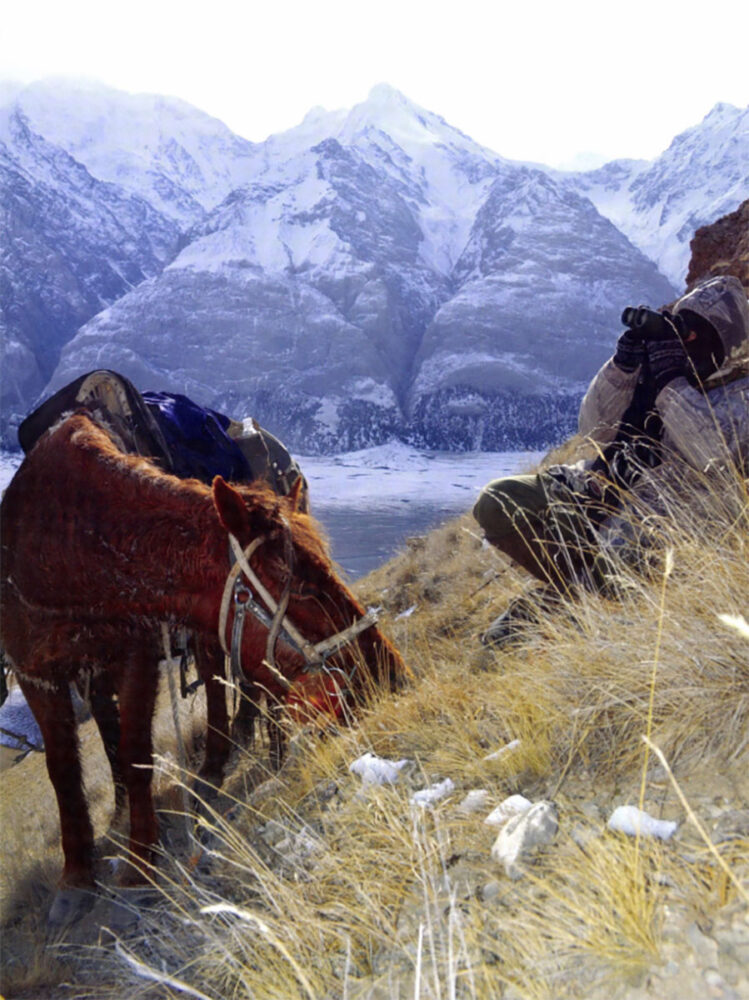
“Akmal watched the horses and kept his glass on the dark, white-saddledbilly from far below.”
Mature billies are blocky-chested and thick-shouldered in contrast to the sleeker, tan-colored younger animals. Even the average-sized horns of ibex billies are spectacular. Bek told me several times, “no, one meter,” when I excitedly viewed what to my untrained eyes seemed to be a stud billy. I was beginning to understand that 40 inches was the benchmark, and when you saw it, you really knew it.
On day five, after riding higher and higher, we left the horses and set out on foot. Once again after scattering ibex to the four winds of the Tian Shan, we spotted a lone billy climbing into a series of deep ridges that stacked upward, his dark form disappearing into the silver mist.
Bek nodded, “Beeg.”
When we’d first spotted the billy, we’d left the horses and more importantly, my hiking sticks and precious water, which by then was already frozen. The thought of giving up hundreds of yards of hard-won altitude to retrieve them was almost nauseating. I was banking on the billy to hang upon the first ridge roughly a mile away and pressed on. Little did I know I was about to experience the most grueling conditions in all my years of hunting.
Akmal watched the horses and kept his glass on the dark, white saddled billy from far below. Unbelievably, Bek didn’t wear boots of any kind, yet he was able to scamper across the rocky mess in his surplus wool boot-liners. Under the onslaught of the German invasion, Mother Russia came here for winter soldiers. I could see why. They were made of the same grit as the Shakletons, Everest Sherpas and those who death-raced to be first to the North Pole. If resilience was an Olympic sport, these mountain hunters would be wearing gold.
While Bek skittered ahead, I trudged my way up from behind. Over the past five days my brain and body had taken a terrible beating — from lack of sleep, dehydration, the wicked cold and cruel altitude, and aches, pains and weariness like I’d never felt before. The minus-25 daytime temperatures bit and slashed at exposed flesh. The 12,000- to 14,000-foot altitude bit even deeper.
As I plodded upwards, I felt lightheaded and thirstier than I’d ever been. I knew I was seriously dehydrated and found myself licking dirty snow off rocks for just a taste of wetness.
Ahead of me, Bek cautiously crested the ridge and I saw him look back to wave me up, then disappear over the top. Somehow I made my way to the ridge and looked over where I have never seen a more crushing sight. Bek, just a tiny speck in the distance, was making his way up the next steep ridge more than a half-mile away.
For the first time in my life, after ripping my guts out for decades in the high mountains after game, I really was wondering how much I had left. The loose scree, dusted in slippery ice crystals, had me crawling more than hiking. My thirst was all-consuming. Tired and weary is one thing, utter exhaustion another.
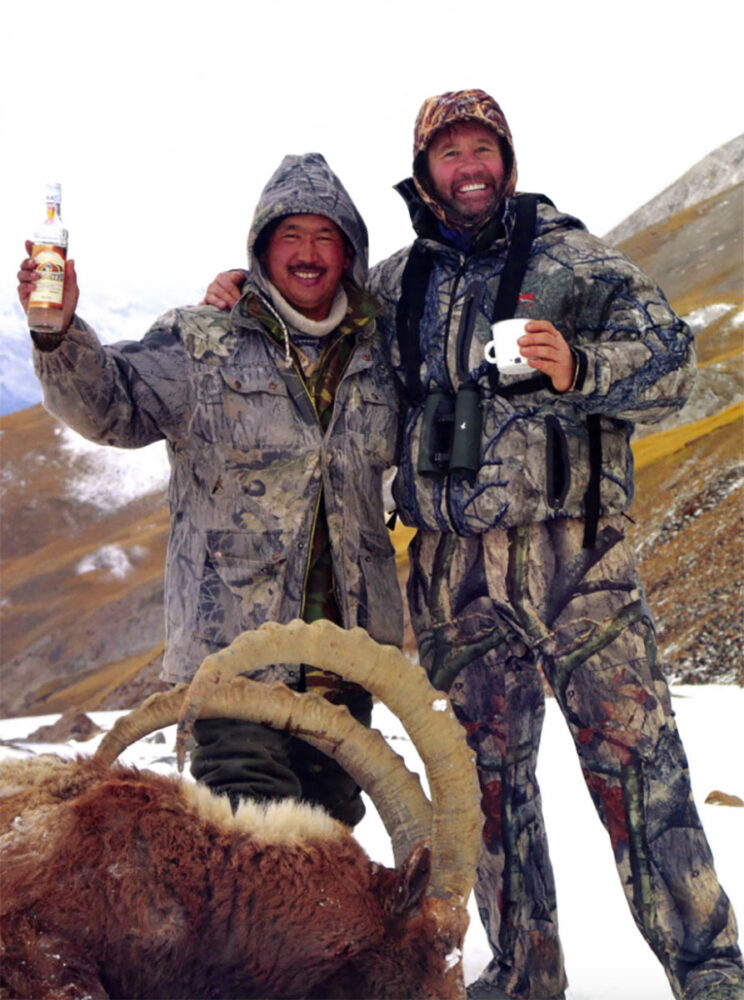
They offered a toast to our hunt, God and our worthy quarry, then poured a splash across the billy’s horns.
I saw Bek drop back toward me, wave excitedly and then point over his ridge. I reached deeper than ever before and started forward, struggling no more than a few feet at a time across the punishing terrain. Somehow I was able to scramble and crawl over to Bek’s vantage point where I prayed under my breath for the billy to be there. Bek indicated the ibex was lying down on the backside of the ridge, close enough for a shot.
He was a king of the Tian Shan, crowned with heavy, sweeping horns and wearing along beard. Even lying down the brute filled my scope; then suddenly he was on his feet, tense and looking back. He had just started to swing his head and bound away when I set the crosshairs on his shoulder, took a deep, ragged breath and pulled the trigger. The rifle’s crack shattered the air, instantly followed by the sweet, hard thwack of the bullet hitting flesh and bone.
The billy turned his great head just as I was ready to fire again and took one step forward . . . into nothingness. The surest footing on earth had failed him and he began tumbling and careening and even somersaulting down the steep mountainside.
I watched helplessly in nauseating awe. His long sabers swung wildly like some crazy buccaneer hacking at the air. He landed in a chute of loose rock shards, then rode that stone wave hundreds of yards to the valley floor where he slid to a stop on the frozen stream.
He was remarkably still in one piece and wore a heavy winter coat colored of slate, wolverine black and ivory that smelled of hard musk. His horns were 47 inches of knotted bone with 11-inch bases as thick as a Siberian blacksmith’s forearm and after that wild crash, apparently just as tough.
Bek and Akmal wore big smiles as they broke out a small bottle of Russian vodka. They offered a toast to the hunt, God and our worthy quarry, then poured a splash across the billy’s horns. The cold, bitter vodka burned sweetly, softening my ragged edges.
As we made our way out of those tremendous mountains, I had the passing thought that they’d stood as long as time itself, and would stand just as strong, long after man no longer walks the earth. For these ancient stone gods, we were merely a passing thought — and already forgotten.
But I wouldn’t forget. I started my journey looking for all things wild and found both heaven and hell in the cold heart of the Tian Shan. I had been humbled and awed by the quiet strength and power of its vastness and moved deeply by the warmth and toughness of its people. I now understood in a profound way what those hunters’ exhausted smiles meant in those images that so many years ago had instilled in me an undying sense of wonder.
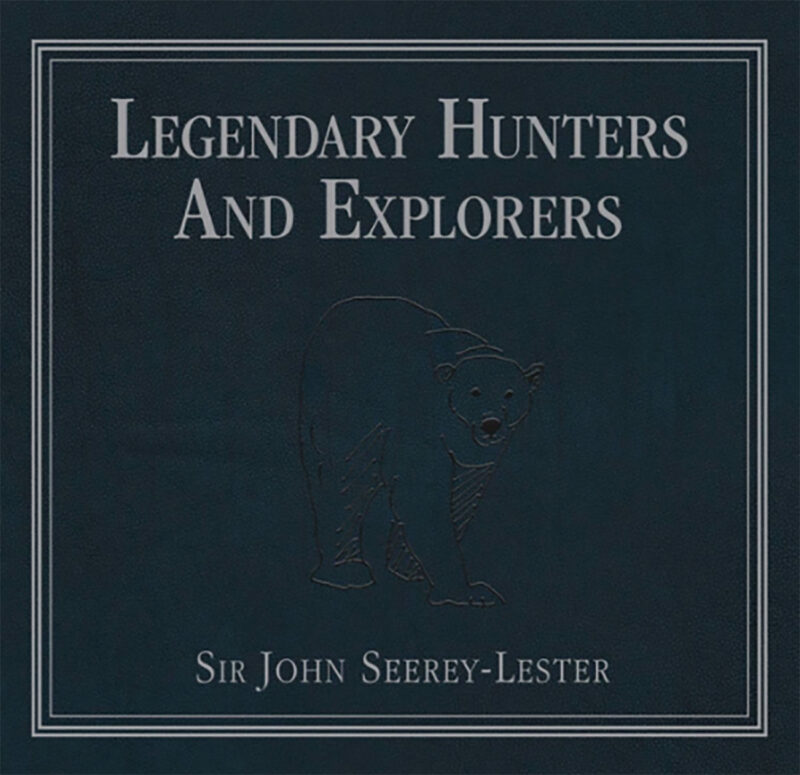 Finishing the final book in the iconic Legends series, Legendary Hunters and Explorers is the epitome of Sir John Seerey-Lester’s spirit. Filled with over 120 paintings and 45 descriptive chapters, the new 200-page book relives the compelling stories of 25 acclaimed hunters and explorers.
Finishing the final book in the iconic Legends series, Legendary Hunters and Explorers is the epitome of Sir John Seerey-Lester’s spirit. Filled with over 120 paintings and 45 descriptive chapters, the new 200-page book relives the compelling stories of 25 acclaimed hunters and explorers.
Amid his fight against cancer, Sir John Seerey-Lester was working tirelessly on his final book of the Legends series, Legendary Hunters and Explorers, when he passed away in May of 2020. He is survived by his wife and fellow artist, Suzie Seerey-Lester, who carries his torch with vigor and pride. Suzie visited the Sporting Classics office to see the fruits of her beloved husband’s lifelong passion and labor finally in print and to sign her name on the project she completed in his honor. Buy Now

